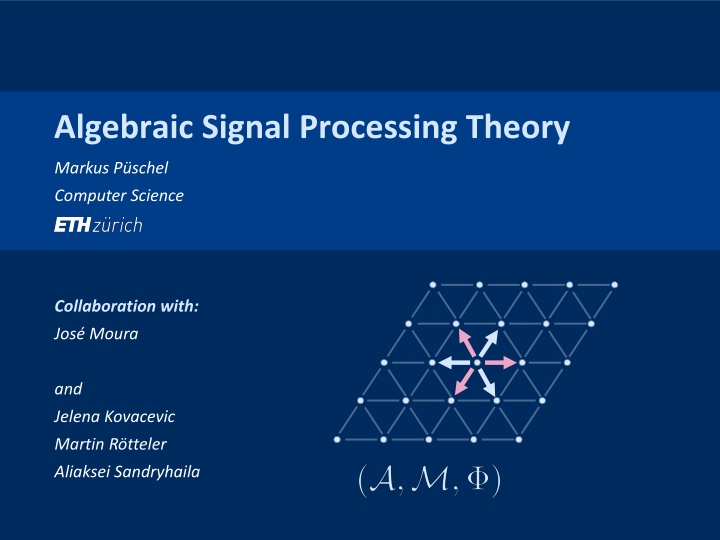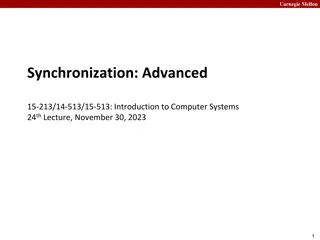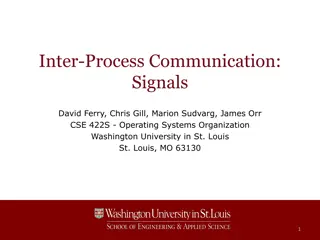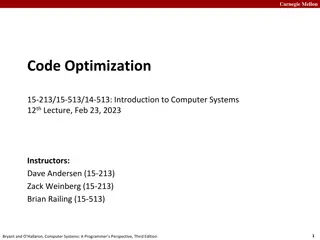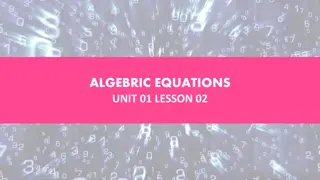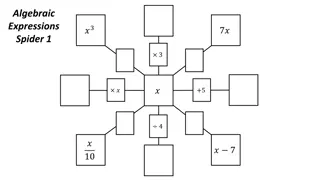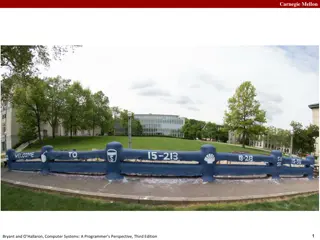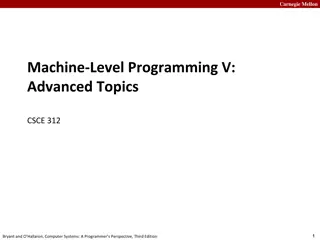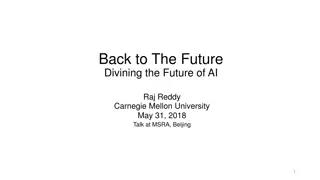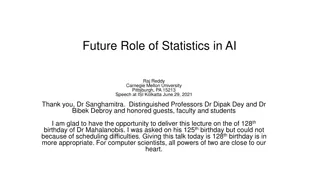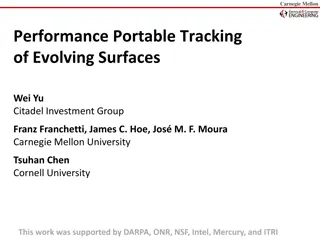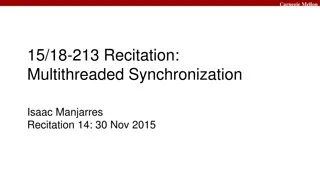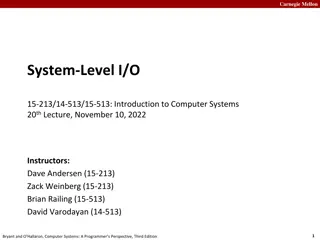Carnegie Mellon Algebraic Signal Processing Theory Overview
Carnegie Mellon University is at the forefront of Algebraic Signal Processing Theory, focusing on linear signal processing in the discrete domain. Their research covers concepts such as z-transform, C-transform, Fourier transform, and various signal models and filters. The key concept lies in the algebra of filters and the signal model associated with the z-transform. This comprehensive overview delves into infinite and finite time and space signal processing, showcasing a wide array of applications and theoretical developments.
Download Presentation

Please find below an Image/Link to download the presentation.
The content on the website is provided AS IS for your information and personal use only. It may not be sold, licensed, or shared on other websites without obtaining consent from the author.If you encounter any issues during the download, it is possible that the publisher has removed the file from their server.
You are allowed to download the files provided on this website for personal or commercial use, subject to the condition that they are used lawfully. All files are the property of their respective owners.
The content on the website is provided AS IS for your information and personal use only. It may not be sold, licensed, or shared on other websites without obtaining consent from the author.
E N D
Presentation Transcript
Carnegie Mellon Algebraic Signal Processing Theory Markus P schel Computer Science Collaboration with: Jos Moura and Jelena Kovacevic Martin R tteler Aliaksei Sandryhaila
Carnegie Mellon Theory 2 Picture: http://www.christianch.ch/images/andere_gefahren.png
Carnegie Mellon Preliminaries ASP = algebraic signal processing theory Algebra: theory of groups, rings, and fields Scope of ASP: linear signal processing This talk: Focus on the discrete case 3
Carnegie Mellon Other/n ew models Signal processing concepts Infinite time Finite time Infinite space Finite space ASP: Generic case z-transform Finite z-transform C-transform Finite C-transform Set of signals Laurent series in z-n Polynomials in z-n Series in Cn Polynomials in Cn Set of filters Laurent series in z-n Polynomials in z-n Series in Tn Polynomials in Tn Fourier transform DTFT DFT DSFT DCTs/DSTs Convolution Spectrum Derivation Frequency response Fast algorithms Filter banks 4 <many others>
Carnegie Mellon Other/n ew models Signal processing concepts Infinite time Finite time Infinite space Finite space ASP: Generic case z-transform Finite z-transform C-transform Finite C-transform Set of signals Laurent series in z-n Polynomials in z-n Series in Cn Polynomials in Cn Set of filters Laurent series in z-n Polynomials in z-n Series in Tn Polynomials in Tn Fourier transform DTFT DFT DSFT DCTs/DSTs Convolution Spectrum Derivation Frequency response Fast algorithms Filter banks 5 <many others>
Carnegie Mellon Big Picture Key concept in ASP: Signal model: algebra of filters signal module associated z-transform Examples: Infinite and finite time or space, many others Signal model defined: all other concepts follow Signal Filter z-transform Spectrum Fourier transform Frequency response Fast algorithms many other concepts Signal model 6
Carnegie Mellon Big Picture Key concept in ASP: Signal model: algebra of filters signal module associated z-transform Examples: Infinite and finite time or space, many others Signal model defined: all other concepts follow Element of module Element of algebra Mapping into module Irreducible submodules Decomposition into irred. submodules Irreducible representation Stepwise induction many other concepts Signal model 7
Carnegie Mellon Organization The algebraic structure underlying linear signal processing From shift to signal model: Time and space From infinite to finite signal models Fast algorithms Conclusions 8
Carnegie Mellon Algebraic Structure of Signal and Filter Space Signal space, available operations: signal = signal signal + signal = signal vector space filter Filter space, available operations: filter = filter filter + filter = filter filter filter = filter filter vector space filter ring filter filter Filters operate on signals: filter signal = signal filter signal signal Set of filters = an algebra Set of signals = an -module 9
Carnegie Mellon (Algebraic) Signal Model Signals arise as sequences of numbers Need to assign module and algebra Example infinite discrete time: z-transform: Signal model (definition): algebra of filters an -module of signals linear mapping 10
Carnegie Mellon Algebras Occurring in SP: Shift-Invariance What is the shift? A special filter x (=z-1) = an element of Filters expressible as polynomials/series in x shift(s) = generator(s) of Shift-invariance: signal model is shift-invariant is commutative Shift-invariant + finite-dimensional (+ one shift only): is a polynomial algebra 11
Carnegie Mellon Example: Finite Time Model and DFT Finite signals: Signal model: signals filters filtering = cyclic convolution finite z-transform Spectrum/Fourier transform: Chinese remainder theorem 12
Carnegie Mellon Summary so far Signal model Shift-invariance: is commutative in addition finite makes a polynomial algebra Infinite and finite time are special cases of signal models How to go beyond time? Answer: Derivation of signal model from shift shift signal model 13
Carnegie Mellon Organization The algebraic structure underlying linear signal processing From shift to signal model: Time and space From infinite to finite signal models Fast algorithms Conclusions 14
Carnegie Mellon Time Space shift (time) marks k-fold shift realization of (time) marks signals filters 15 Chebyshev polynomials
Carnegie Mellon Time and Space (cont d) Chebyshev polynomials Time: done z-transform Space: each a linear combination linearly independent of Cn, n 0 Signal model only for right-sided sequences: C-transform 16
Carnegie Mellon Left Signal Extension Chebyshev polynomials Infinite space model: left signal extension depends on choice of C linearly independent Simplest signal extension: monomial Monomial if and only if 17
Carnegie Mellon Visualization Infinite discrete time (z-transform) Infinite discrete space (C-transform, C = T, U, V, W) -1 left boundary 18
Carnegie Mellon Organization The algebraic structure underlying linear signal processing From shift to signal model: Time and space From infinite to finite signal models Fast algorithms Conclusions 19
Carnegie Mellon Derivation: Finite Time Model ? Solution: Right boundary condition Monomial signal extension: (a = 1: finite z-transform) Visualization: 20
Carnegie Mellon Derivation: Finite Space Model ? Monomial signal extension: For each four cases 16 finite space models 16 DCTs/DSTs as Fourier transforms 21
Carnegie Mellon 16 Finite Space Models Example: Signal model for DCT, type 2: Visualization: 22
Carnegie Mellon 1D Trigonometric Transforms Signal models for all existing (and some newly introduced) trigonometric transforms (~30) Explains all existing trigonometric transforms Gives for each transform associated z-transform , filters, etc. source: Algebraic Theory of Signal Processing, Arxiv 23
Carnegie Mellon More Exotic 1-D Model Generic next neighbor shift Space variant but shift invariant Connects to orthogonal polynomials Applications? 24
Carnegie Mellon Top-Down: 1-D Time (Directed) Models sampling in frequency finite or compact (periodic) infinite continuous sampling discrete 25
Carnegie Mellon Top-Down: 1-D Space (Undirected) Models sampling in frequency finite or compact (xx-symmetric) infinite 4 choices 2 choices continuous sampling 16 choices 4 choices discrete 26
Carnegie Mellon Finite Signal Models in Two Dimensions Visualization (without b.c.) Signal Model Fourier Transform time shifts: x, y 2-D time, separable 16 types space shifts: x, y 2-D space, separable 27
Carnegie Mellon time shifts: u, v time, nonseparable space shifts: u, v, w space, nonseparable space shifts: u, v space, nonseparable 28
Carnegie Mellon Organization The algebraic structure underlying linear signal processing From shift to signal model: Time and space From infinite to finite signal models Fast algorithms Conclusions 29
Carnegie Mellon Fast Algorithms: Two Schools DFT Cooley-Tukey FFT (general radix) 30
Carnegie Mellon DCT, type III Algorithm derivation Typical derivation (> 200 such papers) Reason for existence? Underlying principle? All algorithms found? 31 G. Bi Fast Algorithms for the Type-III DCT of Composite Sequence Lengths IEEE Trans. SP 47(7) 1999
Carnegie Mellon Cooley-Tukey FFT Type Algorithms assume p decomposes coarse decomposition complete decomposition Example: yields Cooley-Tukey FFT 32
Carnegie Mellon Application to DCTs/DSTs Decomposition properties of Chebyshev polynomials 33
Carnegie Mellon Induced algorithms DCTs/DSTs Real DFTs/DHTs Journal paper shown: special case k = 3 <many more> 34
Carnegie Mellon Algebraic Theory of Transform Algorithms Consolidates the area Few general principles account for practically all existing algorithms General Cooley-Tukey type algorithms General prime-factor type algorithms General Rader type algorithms Derivation is greatly simplified Many (dozens) new algorithms discovered Applicable to existing and novel linear transforms DCTs/DSTs, MDCTs, RDFT, DHT, DQT, DTT, 35
Carnegie Mellon Organization The algebraic structure underlying linear signal processing From shift to signal model: Time and space From infinite to finite signal models Fast algorithms Conclusions 36
Carnegie Mellon Markus P schel and Jos M. F. Moura Algebraic Signal Processing Theory: Foundation and 1-D Time IEEE Transactions on Signal Processing, Vol. 56, No. 8, pp. 3572-3585, 2008 Markus P schel and Jos M. F. Moura Algebraic Signal Processing Theory: 1-D Space IEEE Transactions on Signal Processing, Vol. 56, No. 8, pp. 3586-3599, 2008 Markus P schel and Jos M. F. Moura Algebraic Signal Processing Theory: Cooley-Tukey Type Algorithms for DCTs and DSTs IEEE Transactions on Signal Processing, Vol. 56, No. 4, pp. 1502-1521, 2008 Yevgen Voronenko and Markus P schel Algebraic Signal Processing Theory: Cooley-Tukey Type Algorithms for Real DFTs IEEE Transactions on Signal Processing, Vol. 57, No. 1, pp. 205-222, 2009 Jelena Kovacevic and Markus P schel Algebraic Signal Processing Theory: Sampling for Infinite and Finite 1-D Space IEEE Transactions on Signal Processing, Vol. 58, No. 1, pp. 242-257, 2010 Markus P schel and Martin R tteler Algebraic Signal Processing Theory: Cooley-Tukey Type Algorithms on the 2-D Spatial Hexagonal Lattice Applicable Algebra in Engineering, Communication and Computing, special issue on "The memory of Thomas Beth", Vol. 19, No. 3, pp. 259-292, 2008 Markus P schel and Martin R tteler Algebraic Signal Processing Theory: 2-D Spatial Hexagonal Lattice IEEE Transactions on Image Processing, Vol. 16, No. 6, pp. 1506-1521, 2007 Aliaksai Sandryhaila, Jelena Kovacevic and Markus P schel Algebraic Signal Processing Theory: Cooley-Tukey Type Algorithms for Polynomial Transforms Based on Induction SIAM Journal on Matrix Analysis and Applications, Vol. 32, No. 2, pp. 364-384, 2011 Aliaksei Sandryhaila, Jelena Kovacevic and Markus P schel Algebraic Signal Processing Theory: 1-D Nearest-Neighbor Models IEEE Transactions on Signal Processing, Vol. 60, No. 5, pp. 2247-2259, 2012 37
Carnegie Mellon Related Work on Algebraic Methods in SP Fourier analysis/Fourier transforms on groups G (Beth, Rockmore, Clausen, Maslen, Healy, Terras, ) In the algebraic theory the special case If G non-commutative, necessarily non-shift-invariant Algebraic theory provides associated filters etc., ties to SP concepts Algebraic methods to derive DFT algorithms (Nicholson, Winograd, Nussbaumer, Auslander, Feig, Burrus, ) Recognizes algebra/module for DFT, but only used for deriving algorithms Origin of this work Beth (84), Minkwitz (93), Egner/P schel (97/98) Helpful hints: Steidl (93), Moura/Bruno (98), Strang (99) Algebraic systems theory (Kalman, Basile/Marro, Wonham/Morse, Willems/Mitter, Fuhrmann, Fliess, ) Focuses on infinite discrete time; different type of questions 38
Carnegie Mellon Algebraic Signal Processing Theory: Conclusions Signal model: One concept instantiating different SP methods Signal Filter z-transform Spectrum Fourier transform Frequency response Signal model derivation Shift(s) General (axiomatic) approach to linear SP Deeper insight into SP Applications to date: New signal models (non-separable 2-D) Comprehensive theory of fast algorithms SMART project: www.ece.cmu.edu/~smart 39
Carnegie Mellon back1 Chebyshev Polynomials back2 back3 Defining three-term recurrence: initial: Special cases: n 0 Closed forms: 40
